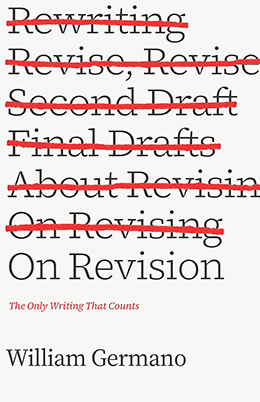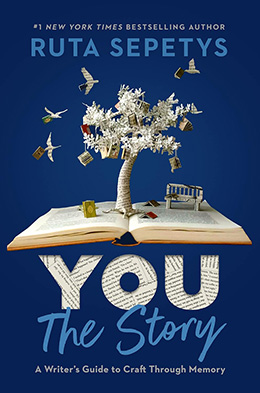How to Get Your Children’s Book Published
Step #7: Fixing It
Hi Educators! In the past six months, we’ve talked about the business of book publishing and the basics of drafting story. Now it’s time for more information on the all-important work of fixing that story, also known as revision.
Revision is covered in almost every book on writing — a few recommendations:
On Revision by William Germano. Though this is written for academic writers, it contains great information, defining revision as “listening and seeing again.”
Writing Picture Books by Ann Whitford Paul. If you are working on a picture book, this is a title to own. You will refer to it frequently and Paul’s chapters on revision are helpful and specific.
You: the Story by Ruta Sepetys. This is not specifically about revision but covers using your own life experiences in writing stories. It’s essential direction for revising details and writing authentic dialogue.
REVISION AS LISTENING
 Using the above definition, revision has two parts, “listening” and “seeing again.”
Using the above definition, revision has two parts, “listening” and “seeing again.”
Let’s start with listening. In revision, we typically both 1) listen to others who read and critique our work (covered a bit in step 5) and/or 2) learn to examine our own writing as readers. Though good critique groups, writing partners, or professional editors are invaluable, those people are not available every day. Most successful writers learn to step back and read their own work as if they were not the one writing it. How do we do that? We read our drafts either aloud or to ourselves all the while questioning what’s on the page. We are actively listening to ourselves as readers of our own work.
Each piece of writing calls up different kinds of questions, but I kept a few notes of the questions considered as I read my recent picture book draft of Houdini’s Library. These examples may be helpful to you to understand the broad and specific issues addressed:
Is it clear that Harry’s family is Jewish? How? Do kids today understand magic tricks? Does a kid know what a shirt factory is? Does a kid know what vaudeville is? (Answers: probably no). How can I stairstep that knowledge into the previous paragraphs to make it clear? What in a kids’ world can be used as examples or metaphors? (answers: messy rooms, working with a partner.) How will that word (examples: modern, Bible) be interpreted? What feelings do the words I’ve used call to mind? (example: strangers carrying off your family stories)
All the while I’m also stopping at every word, phrase, sentence, or paragraph to question, “Does that make sense to a kid? Is it clear? Is it active? Does it move the story along?” I’m listening to myself think through every step of rereading my own work. I’m reading as if I was not the writer.
None of this “listening” can be done in one session. It’s a gradual rereading of the whole manuscript and then rereading at the paragraph, sentence, or word level. While writing, I reread my own work thousands, likely hundreds of thousands of times. On subsequent rereads, authors address the big story components too, asking questions like:
- Does the action build? How, where, and why? Is that building action consistent until payoff at the climax?
- Are the characters individual? How can readers tell them apart? Are their differences in action and dialogue not just description?
- How has each character emotionally changed? Is every major character covered? Do their changes make sense?
- Can I see, hear, feel, taste and touch the environment? Are the details specific and are enough sense words and phrases used throughout to bring those details to life?
- What are the themes? Are they too obvious? Too obscure? Are they consistent? Are they clear but not preachy?
- Is there a satisfying/logical resolution? Why this ending? What does it say to the reader? Is it boring? Or is it the best kind of logical but unexpected?
REVISION AS SEEING AGAIN
As writers we learn to listen to other readers and we listen to ourselves, but the second part, “seeing again,” is the process of answering the questions that come up while listening. We actively search our manuscripts for the broken places, awkward spaces, the overdone and underdone descriptions. Real revision is NOT simply fixing typos and a word here or there (that’s part of copyediting). On the other hand, sometimes taking care of simpler changes will guide you toward the bigger things to fix in the manuscript.
As you revise, the story changes little by little, sometimes you move forward, sometimes back. Even a short picture book manuscript can take weeks or months. Revision is frustrating, it’s hard internal work, and there are days you may think the manuscript belongs in the garbage; but if you stick with it, every day a theme, a character, or a description in the manuscript grows clearer. For more on “seeing again,” author Sarah Aronson has collected all her best posts on revision here.

Most visual artists buy their materials: paint, paper, brushes, or clay. But writers are artists that must make their own materials. I think of drafting as the messy process of making our own clay, our own working materials. That draft clay comes out lumpy or too dry or too wet, and when we roll it up into a whole piece, it has odd bits sticking out. That’s okay. That’s what draft clay is supposed to look like! Revision is the kneading and sculpting of our word-clay into a sturdy, beautiful piece of art that emotionally connects to our audience.

REVISION TIPS
Whenever teaching picture book writing, I share a short series of simple fixes that encourage wider revision. Surprisingly, though I’m not all that experienced at young adult or middle grade writing, I found myself using these techniques even while revising my first long form book for older readers.
- Read out loud. Read out loud. Read out loud. Then, Read out loud! If it sounds wrong, something is wrong. If you think it might be boring, it is boring. If a sentence reads glitchy or awkward, any editor on the planet will find it.
- Show don’t tell. This is a narrative technique that is worth its weight — it even has a Wikipedia page! Showing is a combination of action and sensory description that brings readers into the story. Telling is conveying information. Here’s a short worksheet on the difference.
- Count the words in your sentences and the sentences in your paragraphs. Vary. Good writing sounds alive and has authentic voice. One of the ways to help encourage that kind of writing is to make sure you are using sentences and paragraphs of varying lengths. You don’t want a paragraph full of seven-word sentences. You don’t want long paragraphs one after the other. Writing should have personality behind it.
- Search all word repetitions. Vary (unless a refrain). This is one tip new to many beginning authors. We all have writing ticks, words we overuse, etc. Hunt for all the times you say the same word twice or use the same sentence construction and vary the writing unless it’s a purposeful repeat.
- Search the draft for all the words that end in –ed, ‑ing. And do not rely on “is” verbs or adverbs. Are there ways to make your verbs more active? Can more action be shown not told? What does that action say about the characters? Be specific.
- Do your verbs relate to your theme? Verbs that mean more than one thing or infer are best. In a recent draft, I used the verb “haunted,” in the mental anguish sense (not ghosts) even though the book is about spirit mediums. For a picture book I’ll often write my main theme, for example: FRIENDSHIP at the top of the revision to make sure I head toward that theme with every change.
- Play with writing. Make up words, experiment with a character, try writing the draft from a minor character’s point of view. Notice how the story changes and how your feelings change when you allow yourself the time to play.
- Do not be afraid while revising. If you are afraid of forgetting something you’re deleting, then save a separate file of “outtakes.” You’ll have them if you need them and can continue revising without worry. (P.S. In 15 years, I’ve never used anything from an outtake file…but I still need the security of hanging onto old writing until the book is finished.)
Revision takes practice. It is not a set of skills to learn in a day or a week. It is the heart of the craft of writing and the discovery process by which writing improves enough to be published. If you write, you revise. Over the past two days, I’ve made a few hundred changes while revising this one article you’re reading now.
The next article, our last, will be a summary of this series on publishing for educators. Until then, a challenge! Take three paragraphs from your current work in progress and revise them using at least two of the techniques above. What did you discover? If you want to share, email me at [email protected]. I’ll be waiting to hear from you.
More from this series …
Step #6, Writing Story




The writer/ sculptor comparison is apt! This article gives both new and veteran authors some great tips. Thank you, Barb!